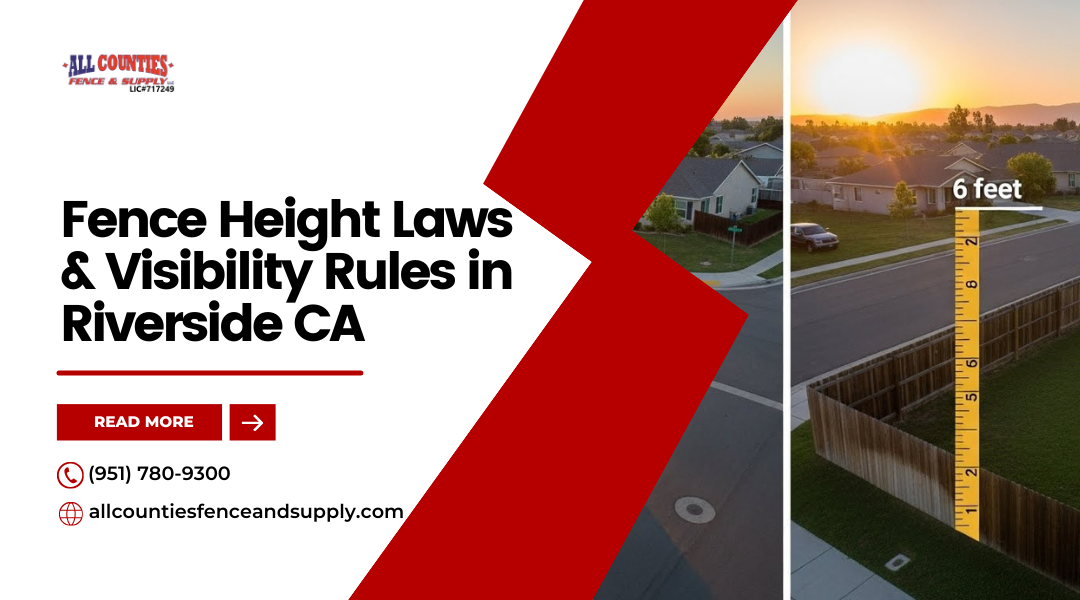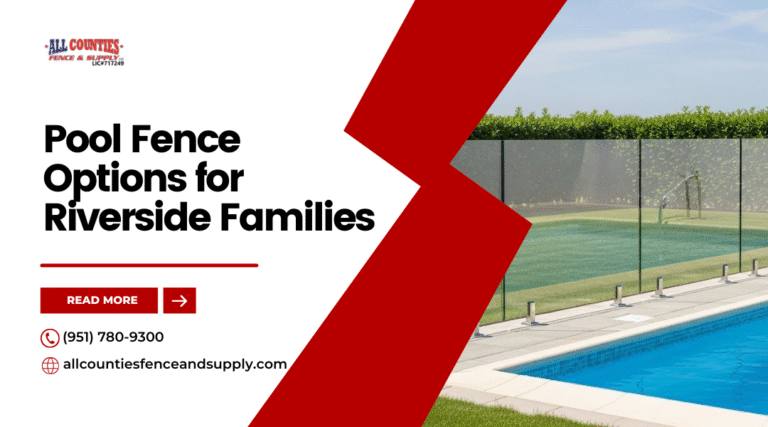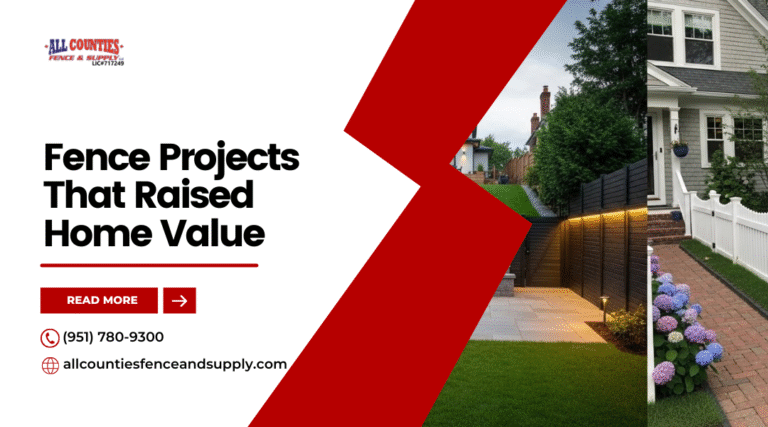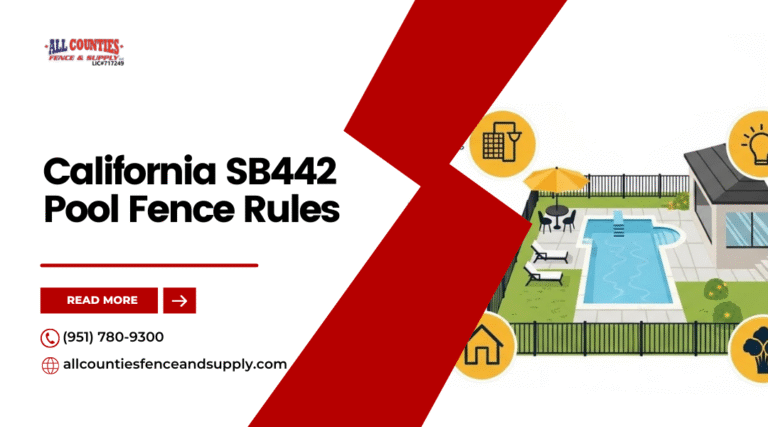Understanding how tall a fence can be in Riverside, CA helps you avoid costly mistakes and neighbor disputes. The city sets clear rules that balance privacy, safety, and neighborhood appearance. In most Riverside neighborhoods, fences can be up to 4 feet high in front yards and up to 6 feet high in back or side yards, with lower limits near driveways to maintain visibility for traffic safety.
You might think fence height is only about looks or privacy, but it also affects property value and compliance with local codes. Riverside’s regulations ensure fences don’t block sightlines or create hazards at intersections. These laws also help maintain consistent curb appeal across residential areas.
Knowing the height and visibility rules before building or replacing your fence keeps your project simple and conflict-free. Whether you’re upgrading a backyard barrier or working along a shared property line, understanding local law helps you make informed decisions and stay on the right side of Riverside’s fence requirements.
Overview of Fence Height Laws in Riverside, CA
In Riverside, fence regulations determine how tall you can build a fence based on its location on the property and the zoning district. These rules also outline how to measure height and what materials are acceptable for safety and visibility.
Local Ordinances and Zoning Regulations
The City of Riverside enforces fence laws through Chapter 19.550 of the Riverside Municipal Code (RMC). These rules apply to fences, walls, and hedges, ensuring they meet both safety standards and neighborhood design goals.
Local zoning determines the maximum heights allowed. Residential, commercial, and corner lots often have specific limits to maintain visibility at driveways and intersections. The city’s zoning code also includes sight clearance requirements, which help prevent visual obstructions for drivers and pedestrians.
In most residential areas, your fence must be built from approved materials and meet placement guidelines. Using untreated wood, sharp wire, or hazardous materials is prohibited under § 19.550.020 (Prohibited Materials). You may also need a permit for fences exceeding standard limits or when constructing near property lines.
To confirm compliance, review both the City of Riverside’s zoning map and any applicable California fence laws, which provide general standards for neighbor boundaries and shared costs.
Front Yard, Side Yard, and Backyard Height Limits
Riverside generally restricts fences in front yards to around 3 to 4 feet, depending on proximity to streets and sidewalks. These limits maintain a clear view of traffic and preserve the open appearance of neighborhoods.
In side and backyard areas, you can often build taller fences—commonly up to 6 feet—to increase privacy and security. However, corner lots and driveways may require lower fences or visibility triangles that stay clear of obstructions up to 3 feet high near intersections.
| Fence Location | Typical Maximum Height | Purpose |
|---|---|---|
| Front Yard | 3–4 ft | Maintain visibility |
| Side/Back Yard | 6 ft | Privacy and enclosure |
| Near Driveway Corners | 3 ft | Traffic sightlines |
If you live in a gated or historic district, check for additional rules under § 19.550.070, which may restrict design and materials for aesthetic consistency.
Measuring Fence Height: Standards and Methods
The city measures fence height from the lowest point of finished grade next to the fence to its highest point, including posts or decorative elements. If your property slopes, the measurement follows the grade line, not the top of a retaining wall.
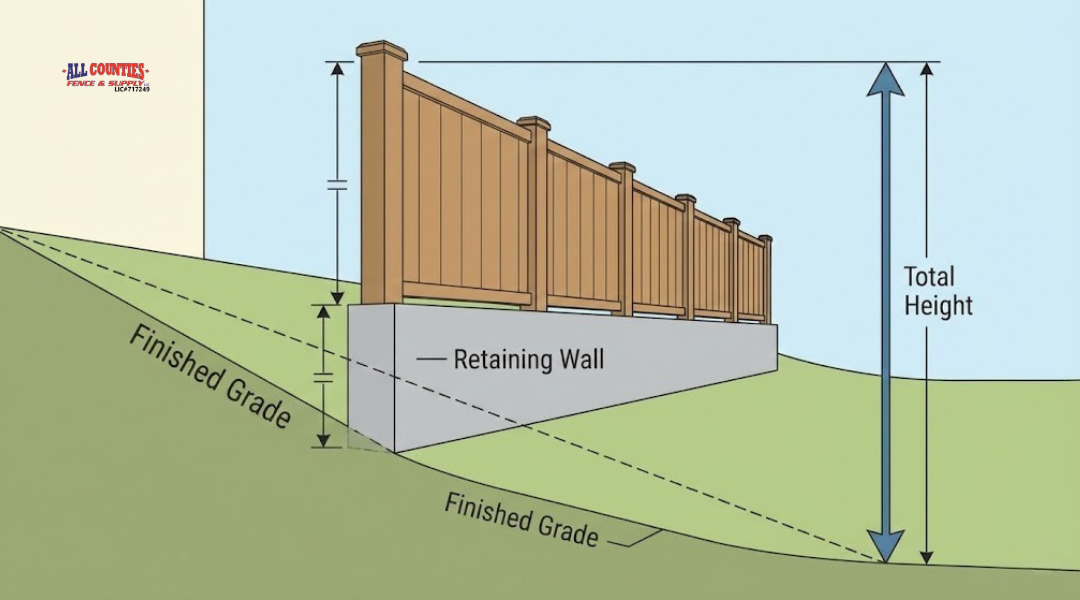
When a fence sits atop a wall, both structures count toward the total allowable height. For example, a 2-foot wall with a 4-foot fence equals a total height of 6 feet.
You must ensure your fence stays within these combined limits, especially along property lines shared with neighbors. Always measure carefully before construction to avoid code violations and costly modifications later.
These standards help maintain uniformity across neighborhoods while protecting visibility and compliance with California building and zoning rules.
Visibility and Safety Requirements for Fences
In Riverside, fence visibility rules protect both drivers and pedestrians by maintaining clear sight lines at corners, driveways, and intersections. You must follow these standards to reduce traffic hazards and avoid code violations.
Sight Triangle and Corner Lot Restrictions
On corner lots, you must maintain an unobstructed sight triangle so drivers can see cross traffic and pedestrians. The City of Riverside generally requires a 10-foot visibility triangle at each street intersection where fences, walls, or hedges cannot exceed 3 feet in height. This area starts at the corner where property lines meet and extends along both sides of the adjoining streets.
If your property borders an alley or minor street, smaller triangles may apply—typically 7½ feet on each side. Check the city’s zoning or planning map for confirmation. Taller fencing within these triangles may need approval through an encroachment permit or variance.
Vegetation and decorative elements can also block a driver’s view. Avoid solid materials, and keep shrubs trimmed below 3 feet in restricted zones. Regular maintenance ensures compliance and keeps your property safe for road users.
Driveway and Intersection Visibility
Any fence, wall, or hedge next to a driveway entrance must allow a clear view of oncoming vehicles, cyclists, and pedestrians. Riverside typically enforces a 5-foot visibility zone on each side of a driveway. Within this area, solid fencing over 3 feet high can create blind spots and violate municipal safety codes.
For properties near signalized intersections or curves, visibility requirements may be stricter. You should measure the line of sight from a driver’s seated position—about 3.5 to 4.5 feet above ground—to ensure roughly 150 feet of clearance in both directions, depending on the road’s speed limit. Using open designs like wrought iron or split-rail fences keeps your property secure without blocking views.
Documenting sight distances during planning or permitting can help you avoid corrections later. Many homeowners submit simple diagrams in their permit applications to show compliance.
Materials Affecting Visibility Compliance
Fence materials significantly affect visibility within required sight areas. Solid fences—such as wood panels, vinyl, or masonry—block sight lines more than open designs like chain-link or metal pickets. In Riverside, fences in visibility zones should be no more than 50% opaque, allowing drivers to see through the structure.
Choose materials with wide spacing between slats or decorative openings that maintain transparency while giving privacy. In many residential zones, the city encourages blending visibility-friendly designs with landscaping rather than using tall, opaque barriers.
Regular upkeep matters as well. Repainting or replacing faded materials reduces glare and keeps surfaces uniform, preventing distractions to drivers. If you plan to install a solid wall near intersections or driveways, contact the City of Riverside Planning Division to confirm whether the design meets local safety and sight distance requirements.
Good Neighbor Fence Law and Shared Property Lines
In California, Civil Code Section 841, known as the Good Neighbor Fence Law, sets rules for fences that sit on shared property lines. It defines how neighbors share costs, upkeep, and communication duties to ensure fairness when building or maintaining boundary fences.
Equal Cost and Maintenance Responsibilities
Under the Good Neighbor Fence Law, both you and your adjoining neighbor are presumed to share equal responsibility for a fence that benefits both properties. This includes the construction, replacement, and repair of fences built on a property boundary. Unless one side can show the fence benefits only one owner, the law assumes costs are split 50/50.
You also share maintenance duties such as painting, cleaning, and minor repairs. This joint responsibility reduces conflict and ensures fences remain functional and in good condition. If the fence serves both properties—by providing privacy or marking a boundary—you cannot expect the other party to pay more than half.
| Responsibility | Requirement |
|---|---|
| Cost of construction | Shared equally unless proven otherwise |
| Ongoing maintenance | Both neighbors share equally |
| Exceptions | Unequal benefit or damage caused by one owner |
Clear boundaries and open communication help avoid confusion about who must pay or perform work.
Written Notice and Cooperation Process
Before changing, repairing, or building a shared fence, you must give your neighbor at least 30 days’ written notice. This notice should describe the issue (for example, fence damage), outline the proposed solution, show cost estimates, and include a suggested timeline.
You can deliver the notice by mail or hand it directly to your neighbor. The goal is to allow time for both parties to discuss the plan and agree on fair terms. Keep a copy of all communications in case disagreements arise later.
If your neighbor disagrees, discuss alternatives such as sharing different proportions of cost or adjusting materials. Cooperation is emphasized under California fence laws, helping you prevent disputes and ensure compliance with local rules, including any city-specific requirements such as those in Riverside, CA.
Permits, Documentation, and Enforcement
Riverside enforces clear standards to ensure fence construction follows safety codes, zoning limits, and California fence laws. You must follow these requirements before building or modifying a fence to avoid penalties and ensure your structure meets local regulations.
When a Permit Is Required
You need a building permit when your fence exceeds certain height or location limits. In most of Riverside, fences up to 6 feet in residential rear or side yards do not require permits, but anything taller usually does. Front-yard fences and those near driveways often face stricter visibility and safety standards.
You must also get a permit if your fence includes retaining walls, electrical elements, or structural posts anchored in shared property lines. Commercial or corner-lot fences can face additional review by zoning officials to ensure compliance with sightline clearance rules.

Failing to obtain a permit can lead to fines or a stop-work order. Inspectors may also require you to remove or lower a noncompliant fence. Checking both the Riverside Municipal Code and California Building Code Title 25 before starting helps you avoid costly enforcement actions.
Application Steps and Required Documents
To apply, begin at the City of Riverside Building & Safety Department. Complete a permit application and attach supporting documentation such as:
| Document Type | Purpose |
|---|---|
| Site plan | Show property lines, fence placement, height, and setback distances. |
| Material list and fence design | Describe type, opacity, and construction method. |
| Neighbor agreements (optional) | Useful when building on or near shared property lines. |
Submit your plans in person or through the city’s online portal. Reviewers check compliance with local ordinances, Riverside County Ordinance 457, and California Building Codes.
After approval, you may need an inspection before final sign-off. Keep records of all correspondence and permits because enforcement officers can request them if disputes or complaints arise later.
Disputes, Encroachments, and Legal Remedies
Boundary fences in Riverside can easily lead to misunderstandings when neighbors disagree about placement, height, or maintenance. California law, including the Good Neighbor Fence Law, outlines shared responsibilities and provides remedies for conflicts related to property lines and encroachments.
Common Neighbor Disagreements
Fence issues often begin with questions about where the property line lies. In many neighborhoods, fences sit directly on the boundary. If the line isn’t clear, one side may accuse the other of encroachment. A professional property survey helps confirm the correct placement.
Another frequent disagreement involves cost sharing. Under Civil Code Section 841, you and your neighbor are presumed to share construction and repair costs equally unless one of you proves the fence provides no benefit.
Height and appearance can also create tension. Riverside generally limits front yard fences to about 3.5 feet and backyard fences to 6 feet, though local zoning rules may differ. Disputes often arise when a fence exceeds these limits or blocks views. Some property owners also object to materials or colors used.
Maintenance responsibilities sometimes cause friction, especially when a fence deteriorates. Each neighbor must help keep a boundary fence in good condition unless there’s a written agreement stating otherwise.
Resolving Issues: Mediation, Agreements, and Legal Action
Open communication usually works best before taking formal steps. Start by discussing your concerns directly and presenting objective evidence, such as survey results or local code citations. Keep a written record of all communications.
If discussion fails, mediation can help. A neutral mediator allows both sides to explain their positions and reach agreement without costly litigation. Many California counties, including Riverside, offer community mediation programs.
When an agreement is reached, it’s smart to document it in writing. A simple contract can specify who pays for what, how maintenance will be handled, and future repair terms.
If your neighbor refuses to cooperate or moves a fence onto your property, legal remedies may be necessary. You may file a civil encroachment claim or request a court order for removal. In such cases, consulting a real estate attorney ensures your rights are protected and that actions follow California’s Good Neighbor Fence Law.
Special Fence Cases and Exceptions in Riverside
Different types of fences in Riverside fall under specific regulations that address safety, neighbor relations, and private governance rules. These requirements help ensure that fences protect property, maintain visibility, and meet community standards.
Pool Fencing and Safety Regulations
Title Page Separator Site title
If you have a swimming pool or spa, you must build a secure barrier that meets California Building Code and Riverside Municipal Code standards. The purpose is to prevent accidental drowning, especially among children.
A pool fence must be at least 5 feet high and have no gaps or openings that a small child could fit through. Gates must be self-closing and self-latching, with the latch placed at least 60 inches above the ground. Chain-link, wrought iron, or solid fences are acceptable if they meet these height and latch rules.
In addition to fencing, you may need other safety features such as alarm-equipped doors or removable mesh barriers when the pool is close to the house. These extra safeguards are required if the property has direct access from indoor spaces to the pool area.
Spite Fences and Nuisance Laws
A “spite fence” is a structure built mainly to annoy a neighbor by blocking light, air, or view. Under California Civil Code Section 841.4, a fence over 10 feet tall that serves no reasonable purpose may be declared a private nuisance.
In Riverside, if you believe a neighbor’s fence qualifies as a spite fence, you can contact Code Enforcement or pursue a civil complaint. Evidence such as photographs, witness statements, or property records can help establish intent.
You are allowed to maintain privacy or security through regular fencing, but using excessive height or unattractive materials to harass a neighbor can lead to fines or mandatory removal. The city typically encourages disputes to be resolved through mediation before further action.
Homeowners Associations and Additional Rules
If your home is part of a Homeowners Association (HOA), your fence must comply with both city laws and HOA covenants, conditions, and restrictions (CC&Rs). An HOA can require you to follow limits on fence height, color, and material, even if city codes would otherwise allow more flexibility.
Before construction, review your HOA’s approval process. Many associations require a written application and design approval before you start work. Noncompliance can result in fines or removal orders from the association.
Below is a quick summary of typical HOA fencing rules:
| Requirement | Common Standard |
|---|---|
| Maximum Height | 6 feet in rear yards, 3–4 feet in front yards |
| Approved Materials | Wood, vinyl, or wrought iron |
| Color Restrictions | Neutral tones; bright colors often prohibited |
Always confirm your project meets both municipal code and HOA standards to prevent costly corrections later.

